If you mention Diving gear to the average person, they will be able to give you a pretty comprehensive list of the gear a diver would need to reach the depths safely. Wet Suit, diving mask, and oxygen tank. Gloves and flippers. But what about a diving computer?
You might have heard of a diving computer before, but maybe you are unsure what they actually do? Do not worry, and you are not alone in that sentiment. There are some veteran divers who wouldn’t be able to tell you.
We are going to be looking at the 5 Best Dive Computers for Beginners. If you are a diving veteran and are looking to upgrade your current diving computer, I’m afraid you won’t find one here. But if you are new to the sport, we have what you need.
But before we can show you the computers, we need to clear up precisely what Diving computers are and what they do.
Buyers Guide for the Best Diving Computer for Beginners
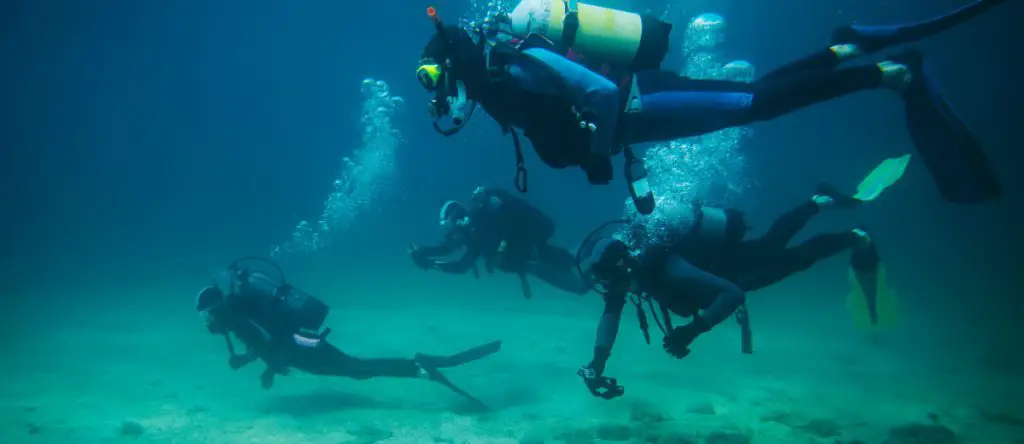
The Basics
A diving computer, to put it simply, is a small wrist computer designed to track all the vital information you will need while diving. It tracks your current Depth, remaining air, temperature, and speed.
The primary use is to monitor your air intake. It doesn’t connect directly to the tank but instead uses a depth sensor and a series of timers to tell you when to change your mix and when to ascend.
The diving computer also assists in your accent. Since you sometimes have to make multiple stops on your way up, the computer can tell you exactly when to stop and when to swim.
So what different features will you find within a diving computer? Let’s break it down.
Algorithms
Diving computers make use of various decompression algorithms to work out when you need to ascend and how much gas you are using. These algorithms are based on your body composition, and the companies own coding. To this end, some computers are more conservative than others when it comes to accent warnings.
The type of algorithm available will be brand-dependent. But two popular algorithms that have popped up in recent years are the Pelagic DSAT and the Pelagic Z+.
DSAT is designed for warmer, more relaxed diving, and it gives the user more control over how conservative it is. The Z+ is designed for colder waters and is helpful for more intense and skilled dives. The Z+’s big selling point is its ability to match the algorithms of other watches, letting you sync your warnings with your friend.
Gasses
When diving, you won’t simply use a canister full of oxygen. Rather it will be a mix of gasses—nitrogen, Oxygen, Helium, and sometimes hydrogen. The mix you use and when you use it will depend on your diving experience and how far down you are planning to go. As a beginner, you will likely only use a nitrogen mix Or Nitrox. Most watches have the algorithms to switch between oxygen-heavy mixes and Nitrox. Some even allow for the usage of Trimex.
SUUNTO RGBM
Suunto is a name you will see pop up a lot in terms of diving computers and diving in general. They are a leading brand in the field and create some of the best products. The RGBM algorithm is a specialized algorithm designed to deal with the dissolved gasses against free gas. Units like the Suunto zoop novo make use of the RGBM algorithm to significant effect. You won’t necessarily need the RGBM algorithm as a beginner, but it’s great to have if it is included.
Display Screen
When selecting your diving computer, you will need to take into consideration what type of display screen you want and what will work best for your skills.
A segmented display screen is a standard used for beginners. These offer essential information in an easy-to-read fashion, much like a digital watch. The downside to this type of screen is the inability to display more complex information.
Colour screens use colors to highlight the more vital information as and when you need it. They also work best in darker areas, so night dives or intense diving situations. You won’t necessarily need this as a beginner, but a color screen will still work great. They also eat up more battery life, so be aware of that.
Weight
When it comes to diving, weight is essential. Water makes you more buoyant naturally, but you aren’t free from the effects of gravity by any stretch of the imagination. The more your equipment weighs overall, the faster you can descend. But, keep in mind, every extra pound of weight will make your accent to the surface a bit more of a struggle.
Of course, as you use up the air in your tank, you will lose a bit of weight. But the difference in weight added by gasses is so minute, and it could be said to be redundant. So, you will want to take the weight of your selected watch into consideration.
Mounted or Wrist
The more common type of dive computers used by beginners are mounted. These units attach to your dive regulator via a special hose.
Mounted units are able to check your tank pressure to keep track of it, but they will need a specialized Air Integration system.
Wrist-mounted ones are smaller but much more accessible, being right at hand. They are often used by those who are far more skilled at diving. They are multi-purpose, being able to function for other sports as well. Of course, this means they miss out on some of the more advanced features of a mounted diving computer.
For beginners, either type can work, and it depends on what they offer and the type of diving you are planning on doing. The most common type used by beginners is wrist computers, due to their ease of reading and simplicity to use. But these models often offer limited functionality.
So, with that all out of the way, let’s dive into the 5 Best Diving Computers for Beginners.
[su_service title=”Mares Puck Pro Plus Black/Black w/Lanyard Coil ” icon=”icon: star” icon_color=”#2D3092″ size=”32″ class=””][/su_service]
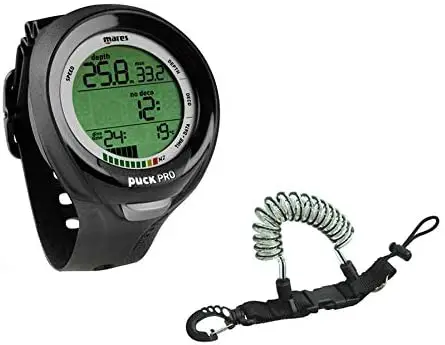
Our first entry on this list comes from Mares. The Puck Pro is a great model for beginners, offering simplicity with great functionality and features.
Features:
- Dive Log Storing up to 35 Hours of Diving
- Ascent Rate Indicator
- Nitrox Programmable
- Diver-Replaceable Batteries
- Multi-Purpose retractor lanyard included
- Unit Weighs 0.7 Pounds
The Puck Pro is one of my favorite units for beginners simply for its outstanding simplicity. I mean that it offers everything you will need for your training without complicating the Interface or functionality with anything unnecessary.
The unit features a Dive Log that can store up to 35 hours of progress, which equates to about 50 Dives. This is fantastic for someone still going through Diving Pool training. It will let you accurately track your training progress and see how far you have come to every step of the way. And, when you finally hit the water, your drives will be short enough that this Dive Log Storage will see you through a lot of Dives.
It has all the basic features you would expect, like being fully Nitrox Programmable. You can use a mix of anywhere between 21-50%. It also has a primary accent indicator, so you will be told when to start your ascent.
The Interface is crystal clear on this unit. All the numbers and information are presented in large, readable font with a backlight. For a beginner, this is extremely useful as you will soon be able to access any information you need at a glance. The addition of a lanyard is also lovely, as you can make doubly sure the computer won’t get lost.
The Puck Pro sits neatly at the $240 mark, making it a reasonable entry-level price for a beginner diver. You won’t break the bank, but you defiantly will get great value for your money.
[su_service title=”Cressi Leonardo Underwater Diving Computer ” icon=”icon: star” icon_color=”#2D3092″ size=”32″ class=””][/su_service]
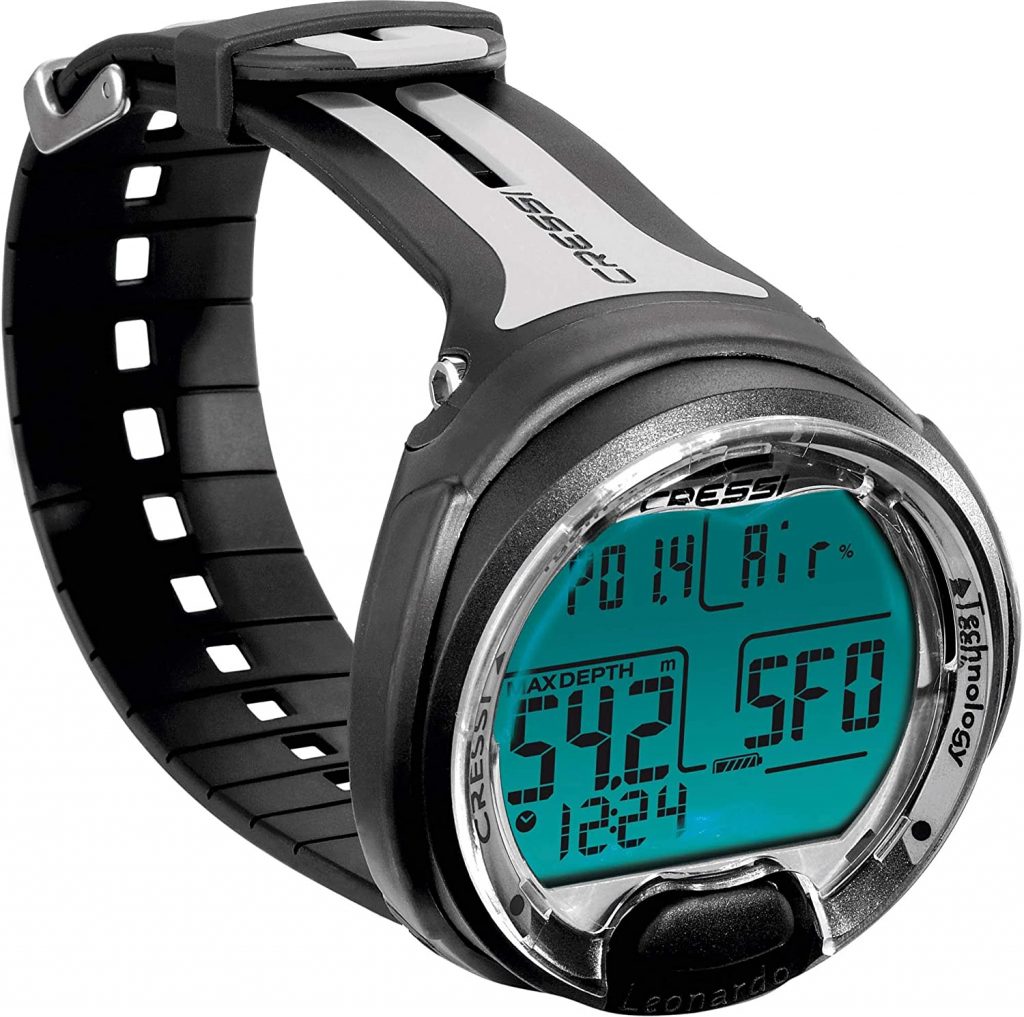
Cressi is a well-known and respected name in the diving world. Working out of Italy, they produce some of the strongest and sleekest diving products anywhere. And the Leonardo Diving Computer is no exception.
Features:
- Dive Log Storing up to 75 Hours
- Nitrox and Gauge Algorithm
- Single Button Control
- High-Definition screen
- Complete PC and Mac support and USB connectivity
- Accent Rate Alarm
- Diver-Replaceable Battery
- CNS Oxygen Toxicity Indicator
- Unit Weighs 0.5 Pounds
Right off the bat, Leonardo is a powerhouse of a diving computer. The Diving Log can store up to 75 Hours of dive information, or 60 Dives at the Beginner level. This is backed up with USB connectivity and both PC and Mac support, allowing you to upload all your data for safekeeping.
It comes with standard Nitrox and Gauge algorithm support, but it also has a CNS Oxygen Toxicity Indication, which can help you actively avoid the bend or nitrogen narcosis.
The screen is easy to read and boasts a high-def display with clearly presented information, making it easy for a beginner to read it at a glance. And the unit is praised for its long battery life.
This unit sits at the $200 mark, making it one of the best diving computers for beginners out there.
[su_service title=”SUUNTO Zoop Novo Wrist Scuba Diving Computer ” icon=”icon: star” icon_color=”#2D3092″ size=”32″ class=””][/su_service]
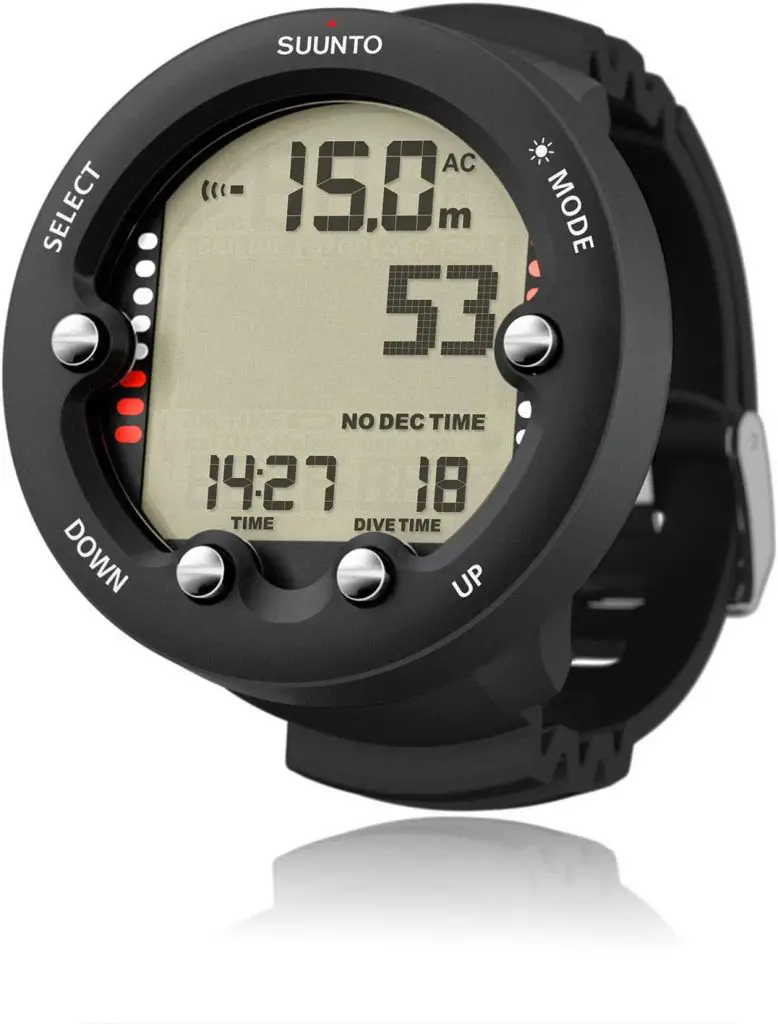
As we said before, SUUNTO is a powerhouse in the diving equipment world, and the Zoop Novo is a great unit for beginners offering great functionality paired with a robust, strong design.
Features:
- Maximum Depth of 100 Meters
- Back Light Display
- Imperial or Metric Programmable
- Nitrox, Gauge, and Freedom algorithms supported
- Accent indicator
- Decompression assist mode
- The unit weighs 0.6 Pounds
The Zoop Novo stands out from other units due to its inclusion of Freedom mode. At the same time, most units will offer Nitrox and Gauge, as this unit does. The Zoop Novo lets you take a more personalized approach, which is great for beginners reaching the stage of being an intermediate diver.
The display is easy to read, with a strong backlight, allowing you to access the needed information at a glance. It comes with the standard accent indicator but also features a decompression assistant mode. This is great for newer divers unsure of how long to stop for.
Being able to program it in imperial or metric is a nice touch as well. This unit sits at the $300 mark, making it a bit pricey, but the inclusion of being usable up to 100 meters makes it a powerhouse unit that is great for beginners and more experienced divers alike.
[su_service title=”Aqua Lung i200 Wrist Computer ” icon=”icon: star” icon_color=”#2D3092″ size=”32″ class=””][/su_service]
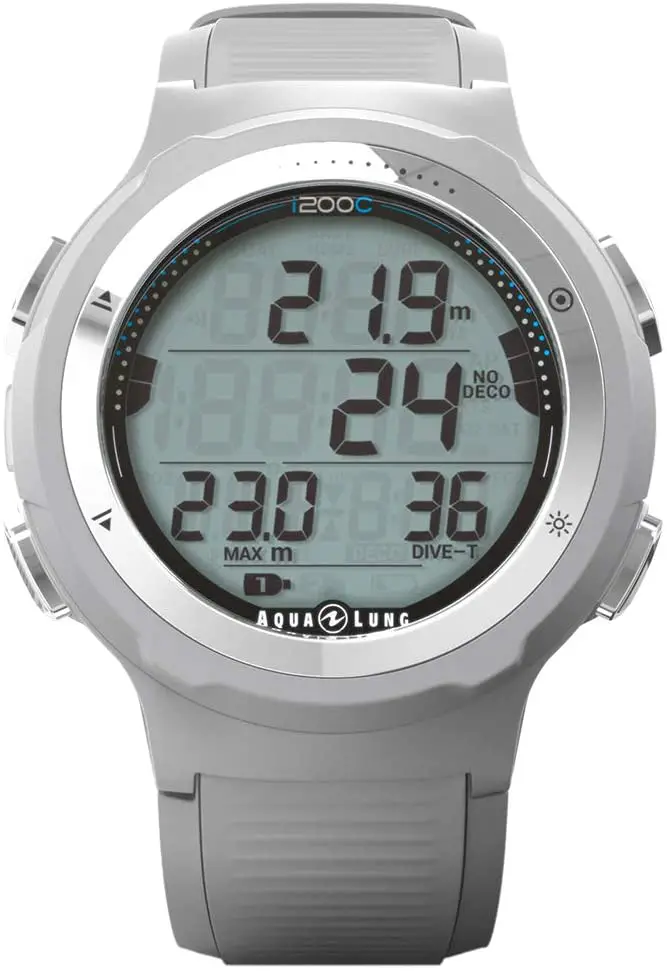
The Aqua Lung i200 is a fantastic unit for those looking for a unit that offers freedom and control paired with a stylish design.
Features:
- Back Light Display
- Nitrox, Gauge, and Free Dive support
- Diver-Changeable battery
- 2 Nitrox Mix support
- Unit Weighs 0.6 Pounds
The power of the Aqua Lung i200 is in its four algorithm support functionality. Being able to switch between Air, Nitrox, Gauge, and Free Dive, the i200 offers more choice and freedom than most watches available for beginners.
And speaking of Nitrox is has two support modes for it, being able to go up to 100% O2 with no restrictions.
The unit is designed to look exactly like a normal sports watch and can function like one as well. It won’t look out of place being worn out and about, making this an excellent choice for a diver who cares about style and fashion. The screen is fully backlit, making it readable and easy to access the needed information.
This unit rests at the $390 mark. You are paying for the style and the amount of freedom this product offers.
[su_service title=”Mares Scuba Wrist Dive Computer Nemo Matrix w/ Retractor Clip ” icon=”icon: star” icon_color=”#2D3092″ size=”32″ class=””][/su_service]
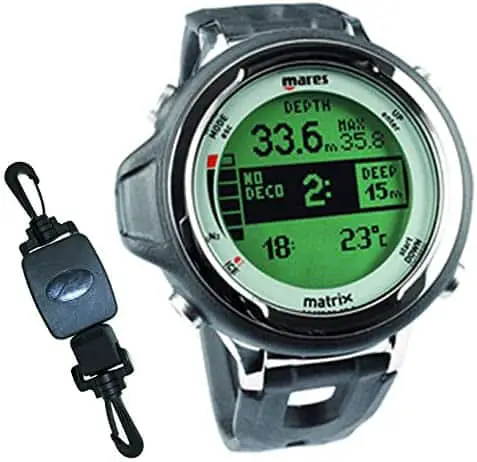
Our final entry is going back to Mares. This time we are looking at the top end of the price range with the Powerful Nemo Matrix.
Features:
- Diving Log of up to 35 Hours
- Logbook includes a graph of your depth profile
- Dot Matrix Display
- Nitrox algorithm included
- Rechargeable battery
- Usable up to 150m Depth
- The unit weighs 0.8 Pounds
The Nemo Matrix offers excellent bang for your buck. The ability to go down to depths of 150M future proof this watch as your diving skills increase and you gain confidence. You won’t have to replace this watch out.
It also features a stopwatch, along with the normal accent indicators and Nitrox support. It also offers support of air mixes up to 99%, so there is a lot of freedom with this unit.
The screen is a dot-matrix display, allowing it to display a lot of information in a clear and concise manner, making it great for beginners who will need to obtain info at a glance. The unit rests at the $440 range, making it the most expensive product on this list, but the staggering battery life and depth ability, paired with the functionality, makes it worth every cent.
We hope this guide has been helpful in helping you find your first diving computer. Remember, whatever you do, stay safe! Diving is great fun, and we welcome you to this fantastic sport with open arms!
